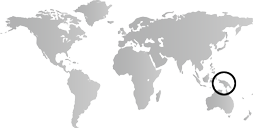In Melanesia, the years 1600–1800 witness sporadic but increasing contact between its diverse peoples and European explorers as well as the first evidence that a number of its classic art traditions are already being practiced. In 1606, Spanish explorer Diego de Prado reports that turtleshell masks are in use in the Torres Strait Islands between Australia and New Guinea. At the headwaters of the Karawari River in New Guinea, the ancestors of the Ewa people begin to create a remarkable series of wooden figures, or aripa. Stored in caves following the death of their owners, they are the oldest known surviving examples of wood sculpture from New Guinea.
In Island Melanesia, explorers continue to make contact with its diverse arts and cultures. In 1643, Isaac Gilsemans, an artist accompanying the Dutch explorer Abel Tasman, creates an image of a group of New Irelanders in a canoe with elaborately sculpted prow and stern ornaments, the earliest record of New Ireland’s intricately crafted wood carving traditions. The drawings made and objects collected during the second voyage of English explorer James Cook in 1774 also offer tantalizing glimpses of the artistic traditions then flourishing in New Caledonia and Vanuatu.


